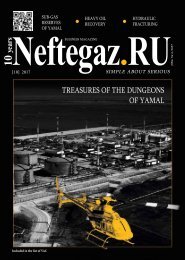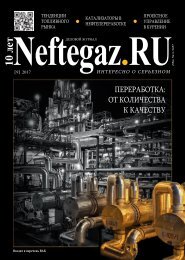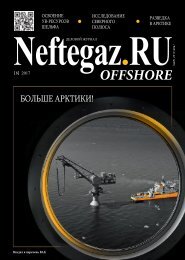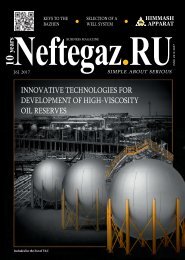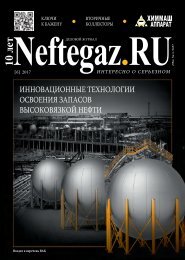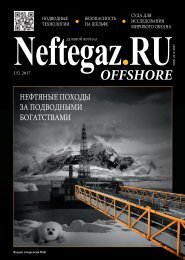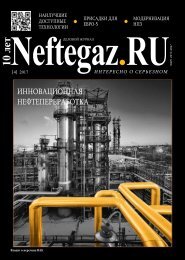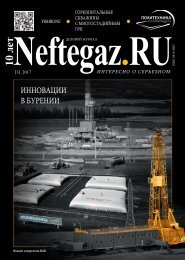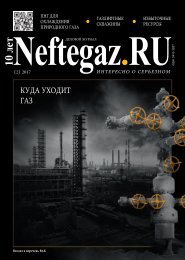Neftegaz.RU #3-17 ENG
Create successful ePaper yourself
Turn your PDF publications into a flip-book with our unique Google optimized e-Paper software.
DRILLING<br />
the Frasnian stage of the Devonian<br />
System. This method is based<br />
on storage of samples in fluids till<br />
appearance of visual destruction<br />
(due to swelling and disintegration)<br />
of clay structure. The testing results<br />
of several types of flushing water are<br />
provided in comparison Table 3.<br />
FIG. 1. Rock samples from mud testing: 1 – SSBPDMI, 2 – polymerclay mud, 3 – SSBPDM<br />
Prior to testing:<br />
TABLE 3. Laboratory testing results<br />
Time to<br />
Mud type<br />
appearance of<br />
destructions, h<br />
Fresh water 0.05<br />
Polymerclay 18<br />
SSBPDM 100<br />
SSBPDMI > 150<br />
Formation water<br />
р = 1.<strong>17</strong> g/cm 3 120<br />
In the process of well construction,<br />
the time of impact of drilling mud on<br />
unstable intervals of log until loss<br />
of their stability and occurrence<br />
of caving formation is of no small<br />
importance.<br />
Data of laboratory testing shows<br />
the advantage of the inhibiting<br />
ability of SSBPDMI over other<br />
similar fluids under examination<br />
After testing:<br />
1 2 3<br />
that is also confirmed by field data<br />
received during drilling of row of<br />
wells at the oilfields of Udmurtia.<br />
Time to occurrence of caving<br />
formation using SSBPDMI is 4 days.<br />
During drilling using polymerclay<br />
mud, it is 24 hours, using SSBPDM<br />
– 2 days. This data is summarized in<br />
Table 4.<br />
TABLE 4. Time to occurrence of instability<br />
of the Kynovian horizon formation since<br />
interval penetration<br />
Mud type<br />
Time, hour<br />
SSBPDMI 98<br />
Polymerclay 24<br />
SSBPDM 48<br />
Conclusions<br />
Drilling mud treated with<br />
sulfonated asphalt in form of<br />
Soltex additive reduces the risk of<br />
caving formation and breaking of<br />
unstable formations (argillites) by<br />
colmatizing micro fractures with<br />
finely-divided oil-soluble part of the<br />
reagent.<br />
In addition, this reagent has the<br />
following advantages:<br />
• it minimizes the damaging of<br />
producing formations;<br />
• it reacts with shale to stop its<br />
sloughing and swelling;<br />
• it significantly increases lubricity;<br />
either alone or synergistically with<br />
small amounts of oils or synthetic<br />
oils;<br />
• it inhibits the dispersion of drilled<br />
cuttings;<br />
• it reduces fluid loss of drilling<br />
mud, reduces dispersability (size<br />
degradation) of cuttings particles<br />
in the process of drilling.<br />
References<br />
1. S.B. Svinitskiy. Forecasting of mining and<br />
geological conditions of drilling wells of salt and<br />
clay deposits with anomalously high pressure of<br />
fluids: thesis of Dr. Sci. in Geology and Mineralogy.<br />
Stavropol, 2007.<br />
2. V.I. Ibrayev. Forecasting of stress conditions of<br />
reservoirs and reservoir-seal rocks of oil and gas<br />
deposits in the Western Siberia. Tyumen: Tyumen<br />
Printing House OJSC, 2006.<br />
3. R.D. Kanevskaya. Mathematic simulation of<br />
development of oil and gas deposits with<br />
application of hydraulic fracturing. Moscow: Nedra-<br />
Business Center LLC, 1999.<br />
4. I.V. Dorovskikh, A.A. Podiyachev, V.A. Pavlov.<br />
Influence of mechanical characteristics change of<br />
rocks during mud saturation on the stressed state<br />
of near-wellbore area // Burenie i Neft. – 2014. –<br />
No.11. – P. 31 – 38.<br />
5. V.N. Koshelev. Development and improvement of<br />
methods for selection and compositions of drilling<br />
fluids: thesis of Ph.D. in Engineering Science, 1988.<br />
6. Chenevert V.E. Glycerol mud additive provides<br />
shale Stability// Oil and Gas J.-II.87. – No.29. –<br />
P. 60 – 64.<br />
7. Recommended Practice for Laboratory Testing of<br />
Drilling Fluids / Note: EIGHTH; ISO 10416:2008<br />
Adoption; Supersedes API RP 131. – P.73 – 75.<br />
8. Method of evaluation of inhibiting abilities of<br />
drilling fluids: AS 1222670 MKI S09К7/00 / A.I.<br />
Penkov, A.A. Penzhoyan, V.N. Koshelev. – Stated<br />
15.08.83 Published 07.04.86. – BI No.13 – P. 3.<br />
46 ~ <strong>Neftegaz</strong>.<strong>RU</strong> [3]



